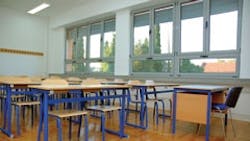Among the most likely candidates for a summertime school modernization are the windows. They are present in nearly every classroom, and even if they have stood up to weather and heavy use, the window units in an existing school may not be as energy-efficient as newer products that have been developed in recent years.
With a new facility, school designers are able to select the building footprint and window placement to optimize energy efficiency. While those choices aren’t feasible in most existing school facilities, education institutions have a number of ways to improve a building’s energy performance through window upgrades.
As daylighting has become an established part of school design, the windows in an education facility fall into two categories: those designed for viewing the outside, and those designed to admit natural light into the building. Designers strive to balance daylight, thermal comfort and energy consumption; the types of windows installed can affect that balance.
The Lawrence Berkeley National Laboratory in Berkeley, Calif., has compiled a guide, "Tips for Daylighting with Windows," that spells out many of the options available to schools and universities.
Some of the key factors to weigh:
•Visible transmittance. This is a measure of the visible light that passes through glazing. "Glazings with a high visible transmittance appear relatively clear and provide sufficient daylight and unaltered views; however, they can create glare problems," the guide says.
•Visible reflectance is a measure of the light that is reflected back from the glazing.
•Solar heat gain coefficient is a measure of the solar heat gain transmitted through the glazing.
•U-Value is a measure of insulation, or the resistance to heat flow.
The glazing decisions to consider in a window upgrade:
•Single or dual pane. Dual-pane glazing has a higher first-cost, the guide says, but it typically improves comfort, offers greater flexibility, improves acoustic performance, and reduces mechanical loads.
•To minimize glare, choose glazing with spectrally selective coating that reflects heat while admitting visible light into a space.
Schools and universities also can install shading devices to control the heat and light that enters a facility.
Exterior shading usually is more effective at blocking solar heat gain than interior shading, the guide says. For south windows, horizontal shading, such as awnings or overhangs, is most useful. Vertical shading is considered most useful on east and west windows. South and west windows should be given shading priority because morning sun usually does not pose a heat-gain problem.
Upgrading windows to improve daylighting in a learning space can be a challenge because the existing windows may not be designed to bring in natural light in sufficient quantities or at the appropriate angles.
One daylighting approach that is a good option for window retrofits, according to The Efficient Windows Collaborative’s Tools for Schools guide is installation of tubular daylighting devices, or tubular skylights. The devices capture daylight from a glazed dome on a roof, and the light travels through a highly reflective tube to rooms below. Before the daylight enters the room, it passes through diffused glazing on the ceiling to deliver more evenly distributed illumination. The reflective tubes enable the system to deliver more light with a smaller amount of glazing than a traditional skylight, and are considered easier to install than a skylight, the guide says.
Kennedy, staff writer, can be reached at [email protected].
Related Stories
About the Author
Mike Kennedy
Senior Editor
Mike Kennedy, senior editor, has written for AS&U on a wide range of educational issues since 1999.
